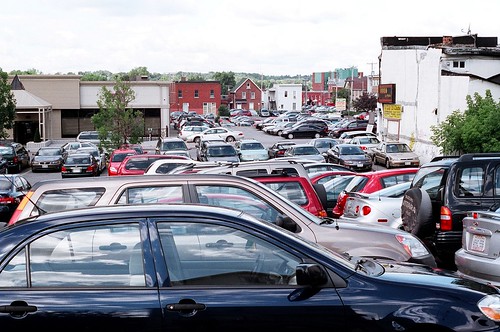 |
there are few frustrations like driving around looking for a parking space, which has its own environmental impacts. Shoup studied a 15-block district in Los Angeles and found that drivers spent an average of 3.3 minutes looking for parking, driving about half a mile each. Over the course of a year, Shoup calculated the cruising in that small area would amount to 950,000 excess miles traveled, equal to 38 trips around the earth, wasting about 47,000 gallons of gas, and producing 730 tons of carbon dioxide that contribute to global warming.
Wonder why the mall parking lot is half empty most of the time? Developers build parking lots to accommodate shoppers on the busiest shopping day of the year -- the day after Thanksgiving -- so that shoppers need never, ever park on the street. Similarly, the church parking lot is designed to accommodate Christmas and Easter services. So a whole lot of land gets paved over that doesn't have to be, transportation planners argue.
So what to do? Make parking free? No. Make it more expensive. "Free" parking is effectively a car-subsidy. It masks the true costs--in real-estate, congestion, fuel, and pollution. Higher prices, on the other hand, should discourage drivers from seeking to park streetside downtown.
For more on parking:
- Spacing.ca talks to Gina Laurel about the invisible aspects of city infrastructure: underground water mains, sewer lines, and the 'empty spaces' we devote to parking.
- Spacing.ca again, this time with a piece on greening parking lots--making surfaces water permeable, including greenery at the periphery, and separating walkways.
- Toronto's city planning board nearly incited a riot when it decided to reclaim the Matador, a dive in Little Italy, and turn it into a twenty-car parking lot. The price tag? Over $800,000, or $40,000 per space.
- Detroit has reclaimed some space of its own, but they're maintaining the unique architecture of the original structure: the ornate Michigan Theater is now a parking garage.
- Congestion pricing seems not to be as regressive as critics charge: although the burden falls more heavily on poor drivers than rich, lowered congestion adds value in the form of newly efficient public transportation--making buses a more viable choice for all.
- New transit hubs may eschew the old model (build a rail station in the middle of a giant parking lot adjacent to a highway interchange) for something new: mobility hubs, enticing cyclists and walkers with lockers, showers, and tree-lined, groomed paths. Giant lots of old would be replaced with paid parking structures and mixed use real-estate.

No comments:
Post a Comment